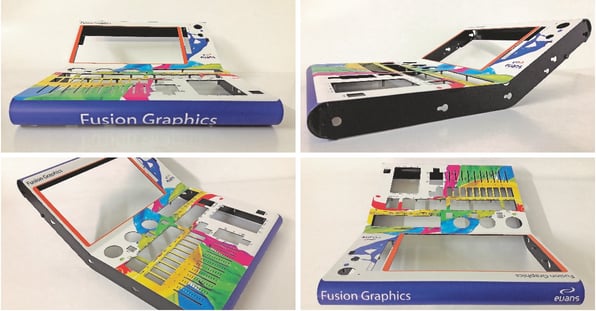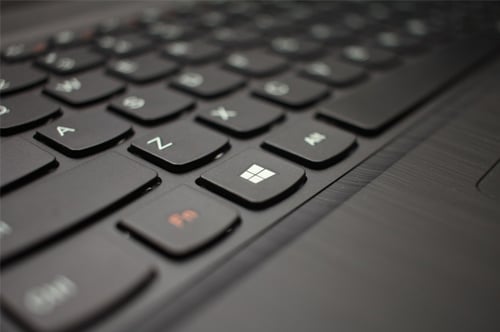You’ll be familiar with fusion graphic overlays even if you don’t realise it. Those of us who encounter electronic switches, nameplates, medical devices or industrial equipment come face to face with them on a daily basis. In fact, anyone with a television does so too.
Defined simply as ‘covers for machinery’ they are commonplace in just about every walk of life. They’re important not just for protecting the apparatus they adorn but providing visual clues as to how to operate them. Keypads would be that bit harder to work without this particular print product.
For as long as graphic overlays have been required, they’ve been screen printed. Indeed, the age old method has been considered the only means in which to produce them. Until now.
As highlighted in recent blogs, Evans Graphics are one of the first print providers in the UK to approach fusion graphics differently. And by differently we mean digitally.
Here we compare the two processes – old and new – and outline the merits, and drawbacks of each. We have the machinery and expertise to deliver high-quality products both ways. So, which will you opt for? Here’s the tale of the tape...
Screen Printed Fusion Graphic Overlays

As mentioned, fusion graphic overlays have traditionally been screen printed. That they’re so prominent in the likes of the electronic, marine, medical and security industries, to name just a few, suggests the process delivers the desired outcome.
Indeed, screen printing overlays has many obvious benefits.
Firstly, it creates products that are resistant to environmental factors and able to withstand both time and elements. Durability is a given. This also ensures all designs retain their visual integrity, as opposed to fading in a matter of months.
Screen printed products are also considered to be of a premium quality, the higher standard one reason why companies order in bulk. Given the preparatory work involved, shorter print runs are less frequent.
You can screen print onto just about anything, such is the versatility of the method. For this reason, screen printing is better suited for specific and/or varying textures, a big plus for those hoping to create bespoke designs.
As for the inks deployed, these can be absorbed deeper... making for clearer edges. Not only that but they can be applied thicker, facilitating deeper colours and darker shades alike, both of which are proven to last longer.
Of course, graphic overlays need to stick to their intended products and those screen printed will do so with minimum fuss. Given the quality and durability of the output, a greater number of adhesives can be used to ensure the adhesive bonds. This may seem like an afterthought but is in fact vitally important.
Screen printing also lends itself to a variety of different finishes. The upshot of this is your chosen substrate can be made to look like something else entirely – stainless steel for instance. This appeals to those seeking a premium look and feel without the associated budget.
Digitally Printed Fusion Graphic Overlays

In the short time Evans Graphics have been printing graphic overlays digitally, we’ve found the process more than stands up to the tried and tested approach. In fact, it shares just as many, if not more benefits for the end user.
Perhaps the biggest difference between the two is the fact digital allows for prototyping and low volume print runs. This presents far more opportunity for those previously discouraged by extensive preparatory work (repro, screen stencils etc.) the cost of which was invariably passed onto the customer. An on demand service can also be offered for a reasonable price.
It goes without saying the turnaround times are far shorter, which offers greater flexibility.
Elsewhere, digitally printed overlays are able to realise more adventurous designs. High quantity colour and tonal effects are created with greater ease, encouraging designers to get creative without fear the end product won’t come up to scratch.
This translates to effects also. We’ve already produced overlays with rim, pillowed and dome embossed areas, as well as what we call ‘high ink build’ – allowing us to elevate a certain section of a design such as a logo. As for the all-important print free windows, necessary for the likes of a keypad, these are incorporated with greater ease and accuracy.
In fact, precision profiling generally is a huge advantage digital holds over screen printing. This is only likely to improve further.
Crucially these fusion graphic overlays are just as durable as the screen printed equivalent. Given how and where they’ll be put to use this is of paramount importance and may be a deciding factor on which process you plump for.
Finally, screen-printed overlays can be created using antimicrobial polyester, simplifying the cleaning process. This has long appealed to the medical industry, for obvious reasons.
Significantly, digital overlays can be printed onto the very same material – heightening its appeal and cancelling out a clear advantage of screen printing.
In summary both processes have their merits, and a good quality graphic overlay is guaranteed whichever side you come down on. The key differentiator is nearly always cost, something we feel will result in more of our customers trying something new... with our help.


